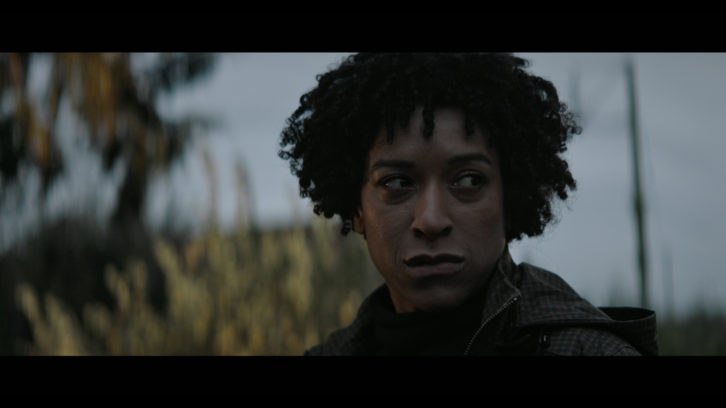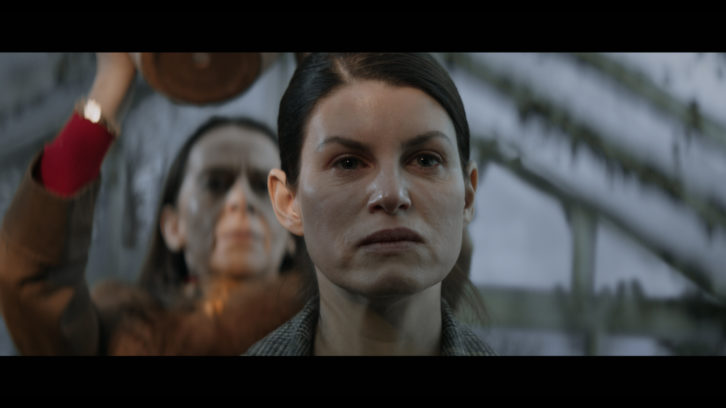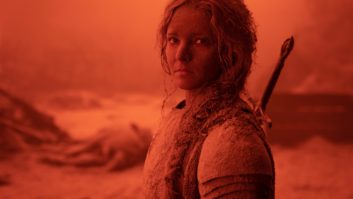Matriarch is a creepy folk horror directed by Ben Steiner, starring Jemima Rooper and Kate Dickie, that follows a lonely media executive who overdoses and has a near-death experience.
She leaves city life and turns to her abusive mother for sanctuary, only to find the countryside village where she grew up in the grip of an unknown gruesome threat.
“Matriarch has a very clear colour palette,” says Michelle Cort, senior colourist at Outpost Facilities. “It’s eerie throughout with muted colours that aren’t overly desaturated. Alan [C. McLaughlin, cinematographer] crafted some dynamically lit compositions for me to work with. There was a lot of work put into holding the colours in their richness and putting tints in, but without making them too bright.”
External light was delicately balanced in the film. Most of the shooting was conducted in winter, with pale skies needing little work, but a few hints of sunshine were added to the composition for emphasis. Cort used the hue curve tool in DaVinci Resolve to ensure the consistency of the sunlight between the different days of the shoot and qualifiers to help with colour separation.

“Ben [Steiner, the film’s director] was clear that the light shouldn’t be a ‘blue wash,’ but it did need to be on the cooler side,” continues Cort. “The film’s climax takes place at night, so we played with the moonlight and just how dark we could take it. The team was very conscious that because it was for Hulu and Disney Plus, the film had to be watchable on phones and tablets, so we couldn’t make it too gloomy.”
One particular challenge that Cort faced was the foliage in the village. Although the film was shot in winter, there had been a lot of rain before filming, and the leaves were particularly bright and verdant. This was inconsistent with the muted tone of the film, so Cort had to keep an eye on ensuring that the colour of the foliage was muted throughout for that less than idyllic feel.
“I used a [DaVinci] Resolve Mini Panel for the grade, which was essential,” she explains. “The trackballs and dials made the fine adjustments much more fluid and intuitive to work through. There was a lot of precision work in keeping the blacks consistent, ensuring they didn’t jump around on the darker scenes. The panel was also useful in controlling the specific blue and green hues we had created. Thankfully, the film featured a lot of long, lingering eerie scenes which allowed us to spend more time fine-tuning each shot!”
“The black ooze was a particular element we had to focus on for consistency throughout the film. As it changed between being practical effects to VFX from scene to scene I had to ensure it was always the same level of black with the same surface texture regardless of whether it was dripping from a person’s face or a larger pooling on the floor. The use of power windows, qualifiers and the midtone detail tool helped with defusing the highlights to create a thicker ooze.”
The film’s finale features a mix of VFX and practical effects some of which were created by the InCameraFX team. For example, the InCameraFX team used a Pocket Cinema Camera 6K to shoot the SFX worms. These were held suspended on a horizontal plate and supervised by the team offsite before the finished shot was integrated into the film.

Resolve was also used for collaboration with the other teams working on the film; in the first instance, keeping track of effects details.
Although most of the teams had been on-site during the shoot, during post-production, there was a need for remote communication between the UK and US. “We worked closely with the producers in LA, using the integration between Resolve and Frame.io to support this,” says Cort.
“We used ClearView [Flex] to do live streams of the grade, as well as outputs at the end of our day, so that the executives and creatives could review progress and provide any feedback via Frame.io. We’d then make further adjustments, which was faster using Resolve because we could quickly use markers to find the segment that corresponded with the comment, rather than having to look up timecodes.”
“All of this contributed to making a superb, creepy feature film, and something I’m very proud of. That said, and without giving too much away, I think it’ll take me a while before I can summon the courage to walk into a greenhouse anytime soon.”
Matriarch was produced by Sharp House and is currently streaming on Hulu and Disney Plus.







